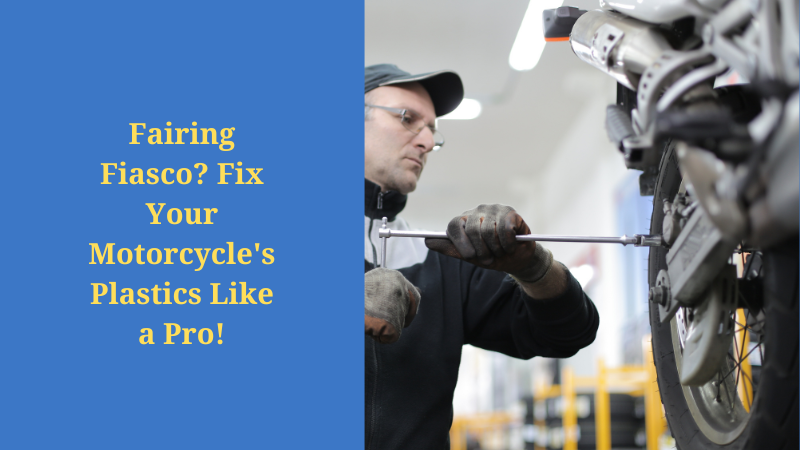Motorcycle fairings are an essential part of a bike’s aesthetics, aerodynamics, and protection. But accidents, road debris, or long exposure to weather can cause them to crack, break, or scratch. If you’re dealing with damaged fairings, this guide will take you through the process of repairing and replacing them with a DIY approach.
If you want to save money on expensive replacements or just love working on your bike, this article offers detailed knowledge, step-by-step instructions, and useful tips. These will help your motorcycle fairings look brand new.

Understanding Motorcycle Fairings
Before starting the repair and replacement process, know what motorcycle fairings do. These panels help with aerodynamics, cut down wind resistance, and shield important parts like the engine and frame from debris.
Fairings come in different types:
- Full Fairings – Cover the entire front and sides of the bike for maximum aerodynamics and protection.
- Half Fairings – Cover the upper part of the bike while exposing the engine.
- Quarter Fairings – Provide minimal coverage, often only around the headlight area.
- Belly Pans – Protect the underside of the bike, particularly in racing models.
Knowing the type of fairing on your motorcycle helps you choose the best repair or replacement method.
Common Causes of Fairing Damage
Motorcycle fairings can sustain damage due to multiple reasons:
- Accidents and Falls – Even a minor drop can cause cracks or scratches on the fairings.
- UV Exposure – Prolonged exposure to sunlight can cause discoloration and weaken plastic fairings.
- Debris and Road Hazards – Rocks, pebbles, and road debris can create dents, scratches, or even cracks.
- Poor Maintenance – Not cleaning or checking fairings often can cause hidden damage to get worse over time.
- Improper Installation or Removal – If fairings are mishandled during installation or removal, it can cause cracks and misalignment.
Knowing the cause of the damage can help you choose the best repair method.
Tools and Materials Required for Repairing Motorcycle Fairings
Before beginning your repair, ensure you have the necessary tools and materials:
Basic Tools:
- Phillips and flathead screwdrivers
- Socket set and wrench
- Sandpaper (various grits: 180, 400, 800, 1200, and 2000)
- Plastic welding kit or soldering iron
- Dremel tool or rotary cutter
- Heat gun (for reshaping warped fairings)
- Safety gloves and goggles
Repair Materials:
- Epoxy resin or plastic welding rods (for ABS plastic fairings)
- Fiberglass repair kit (for fiberglass fairings)
- Bondo or body filler (for smoothing out imperfections)
- Touch-up paint or spray paint
- Primer and clear coat
- Adhesive or plastic glue (for minor repairs)
- Zip ties and plastic clamps (for securing fairings while drying)
With these tools and materials, you’re ready to repair cracked, broken, or scratched fairings.
Step-by-Step Fairing Repair Process
1. Assess the Damage
Start by thoroughly inspecting the fairings to determine the severity of the damage. Small scratches might just need sanding and repainting. But cracks and breaks often need welding or fiberglass patching.
2. Remove the Fairings
- Use a screwdriver or socket wrench to carefully remove the fairings from the motorcycle.
- Keep track of all screws, bolts, and clips to avoid losing them.
- Lay the fairings on a clean, flat surface for easier repair.
3. Clean and Sand the Damaged Area
- Use warm soapy water to clean dirt and grease from the fairing.
- Dry thoroughly and sand the affected area with 180-grit sandpaper to remove any loose or sharp edges.
4. Repairing Cracks and Breaks
For ABS Plastic Fairings (Plastic Welding Method):
- Use a plastic welding kit or soldering iron to melt and fuse the crack together.
- Reinforce the back of the crack with plastic welding rods or mesh.
- Sand the area smooth once cooled.
For Fiberglass Fairings:
- Cut a fiberglass patch slightly larger than the crack.
- Apply resin to the patch and press it over the crack.
- Allow it to dry, then sand smooth.
5. Filling and Smoothing
- Apply a thin layer of Bondo or body filler to cover cracks or deep scratches.
- Once dry, sand with 400-grit sandpaper until smooth.
6. Priming and Painting
- Apply a coat of primer to ensure paint adhesion.
- Let it dry and sand lightly with 800-grit sandpaper.
- Apply matching spray paint in light, even coats.
- Finish with a clear coat for added protection and shine.
Replacing Motorcycle Fairings
If your fairings are beyond repair, replacing them is the best option. Here’s how:
1. Choosing Replacement Fairings
- OEM Fairings: Best fit and durability, but expensive.
- Aftermarket Fairings: Affordable but may require adjustments.
- Custom Fairings: Offer unique designs but can be pricey.
2. Installing New Fairings
- Align the fairings properly before securing them with screws.
- Tighten bolts evenly to avoid misalignment.
- Check for any gaps or loose sections before finishing.
3. Final Adjustments and Inspection
- Test the fairings by lightly pressing on them to check for stability.
- Ensure that all bolts and clips are tightened securely.
- Take your motorcycle for a short ride to check for any vibrations or loose parts.
Preventing Future Fairing Damage
- Use Protective Film or Wraps – Protects against scratches and UV damage.
- Park in the Shade – Reduces sun exposure and fading.
- Avoid Over-Tightening Bolts – Prevents stress cracks in the fairings.
- Regular Cleaning and Inspection – Helps detect minor damage before it worsens.
- Install Frame Sliders – Provides extra protection in case of a fall.
FAQs
1. What tools do I need to repair a cracked motorcycle fairing?
To repair a cracked fairing, you’ll need plastic welding tools, sandpaper (various grits), epoxy or plastic adhesive, a heat gun, a utility knife, primer, and paint for refinishing. Zip ties or fiberglass reinforcement can also help with structural repairs.
2. Can I replace my motorcycle fairings without professional help?
Yes! Many riders successfully replace their fairings at home using basic hand tools like screwdrivers, hex keys, and socket wrenches. Just ensure you follow a step-by-step guide and take photos before disassembly to help with reinstallation.
3. How do I match the paint on my new or repaired fairing?
You can match your motorcycle’s paint by checking the manufacturer’s color code (usually found on the VIN sticker). Alternatively, visit an auto body shop or use color-matching spray paint and clear coat for a professional finish.
4. Is it cheaper to repair or replace a damaged fairing?
It depends on the extent of the damage. Small cracks or scratches can be repaired inexpensively with plastic welding or filler, while severely damaged fairings may need complete replacement. Aftermarket fairings are often more affordable than OEM replacements.
Conclusion
Fixing motorcycle fairings can look tough, but it’s doable. With the right tools, materials, and some patience, you can make your bike’s fairings look like new again. This guide covers everything you need to know. Whether you want to repair cracks, repaint scratches, or replace fairings, you’ll find all the details here.
By following these steps and taking care, you can make your motorcycle fairings last longer. This will help keep your bike looking sleek and well-maintained. So roll up your sleeves, get your tools ready, and bring your bike back to life!
Did you find this guide helpful? Let us know your experience with repairing motorcycle fairings!





